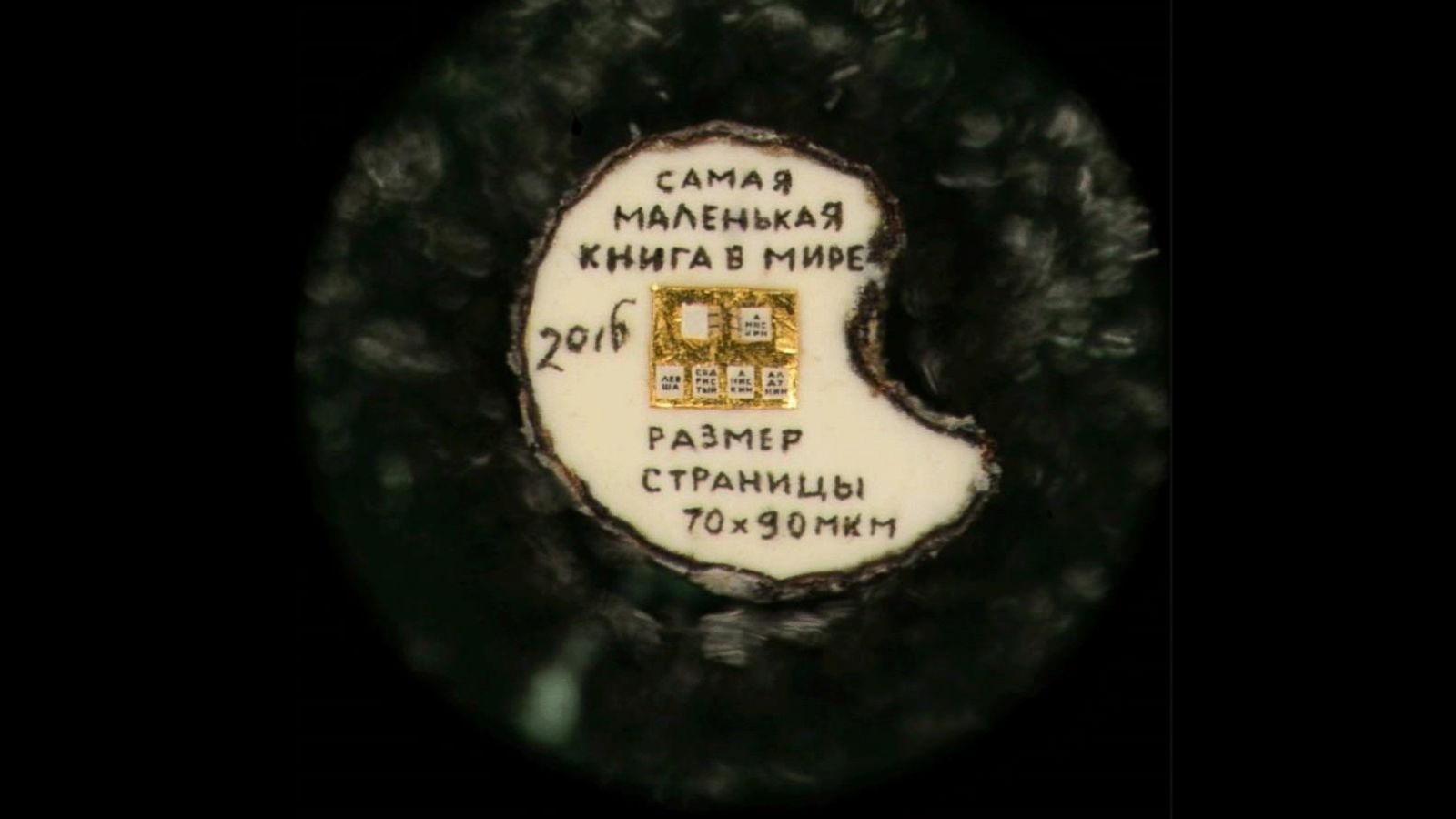What Is The Smallest Book In History?
Have you ever wondered what the smallest book in history is? Well, prepare to be amazed, because we’re about to dive into the fascinating world of miniature literature. From tiny tales to microscopic manuscripts, the smallest book in history holds a grand story within its petite pages. So, grab your magnifying glass and join us on this literary adventure!
In the vast landscape of literature, size doesn’t always matter. Sometimes, it’s the tiniest creations that leave the biggest impact. The quest for the smallest book in history has captivated the minds of bookworms and trivia enthusiasts alike. From the moment we discovered the power of words, we’ve been fascinated by the idea of condensing entire stories into minuscule masterpieces. So, what is the smallest book in history? Let’s unravel this literary mystery together and explore the world of diminutive books that pack a punch. Get ready to be amazed by the wonders that can be achieved within the confines of a tiny tome.

The Smallest Book in History: A Fascinating Tale
Books come in all shapes and sizes, but have you ever wondered what the smallest book in history is? This intriguing question has captivated book lovers and curious minds alike. In this article, we will dive into the world of miniature books and uncover the story behind the smallest book ever created. Prepare to be amazed by the ingenuity and craftsmanship that went into crafting this tiny literary masterpiece.
The Origins of Miniature Books
Before we unveil the smallest book in history, let’s take a moment to explore the origins of miniature books. The art of creating tiny books dates back centuries, with some of the earliest examples dating back to the medieval period. These miniature treasures were often richly decorated and meticulously crafted, serving as symbols of wealth and prestige.
As time went on, miniature books became more accessible to the general public. They were used for various purposes, including religious texts, instructional manuals, and even as novelty items. Today, miniature books continue to capture the imagination of collectors and book enthusiasts, with each tiny volume telling its own unique story.
The Smallest Book Ever Created: A Microscopic Marvel
Now, let’s turn our attention to the main event – the smallest book in history. Tucked away in the annals of literary curiosities is a book that measures a mere fraction of an inch. Known as “Teeny Ted from Turnip Town,” this micro masterpiece holds the title for the smallest printed book ever created.
“Teeny Ted from Turnip Town” was written and illustrated by Malcolm Douglas Chaplin and published in 2007. This remarkable book measures just 0.07 millimeters by 0.10 millimeters, making it smaller than a grain of salt. Despite its tiny size, it contains a fully readable story with illustrations, requiring the use of a microscope to appreciate its intricacy.
The Story Behind “Teeny Ted from Turnip Town”
The creation of “Teeny Ted from Turnip Town” was no small feat. Malcolm Douglas Chaplin, a Canadian artist and writer, spent countless hours perfecting the artwork and text for this minuscule masterpiece. The book tells the whimsical tale of a turnip farmer named Ted and his adventures in a fictional town.
Chaplin’s motivation for creating such a tiny book stemmed from his fascination with miniatures and his desire to push the boundaries of what was possible in the world of bookmaking. By crafting a book that could only be read under a microscope, he challenged the traditional notion of what a book should be, transforming it into a work of art in its own right.
The Impact of “Teeny Ted from Turnip Town”
While the practicality of such a tiny book may be questionable, its impact on the world of bookmaking and artistic expression cannot be denied. “Teeny Ted from Turnip Town” serves as a testament to the boundless creativity and innovation of artists and writers. It reminds us that even in the smallest of forms, storytelling and imagination can flourish.
This tiny book has captured the attention of collectors and enthusiasts around the world, becoming a coveted item in the realm of miniature books. Its existence challenges us to think beyond the conventional and embrace the possibilities of the extraordinary.
Preserving the Legacy of Miniature Books
As we marvel at the smallest book in history, it is important to recognize the significance of miniature books as a cultural and artistic heritage. These tiny treasures offer a glimpse into the past and provide a unique perspective on the evolution of bookmaking.
Fortunately, efforts are being made to preserve and celebrate the legacy of miniature books. Museums and libraries around the world house collections of these delicate works, allowing visitors to appreciate their beauty and historical value. Additionally, organizations dedicated to the art of miniature books continue to promote and support the creation of these tiny wonders.
Exploring the World of Miniature Books
Now that we have uncovered the story behind the smallest book in history, why not delve further into the world of miniature books? From ancient manuscripts to modern creations, there is a vast array of tiny literary treasures waiting to be discovered.
Whether you are a book collector, a lover of art, or simply intrigued by the wonders of the written word, exploring the realm of miniature books offers a unique and enchanting experience. So, grab a magnifying glass and embark on a journey through the captivating world of tiny literature.
Key Takeaways: What is the Smallest Book in History?
- The smallest book ever published is “Teeny Ted from Turnip Town” measuring just 0.07 mm x 0.10 mm.
- It was created using a focused ion beam and can only be read with the help of a scanning electron microscope.
- The book contains a story with 8 pages and requires a magnification of 10,000 times to be legible.
- “Teeny Ted from Turnip Town” was written by Malcolm Douglas Chaplin and published in 2007.
- Although it holds the record for the smallest book, it is not widely available for reading due to its microscopic size.
Frequently Asked Questions
What is the origin of the term “smallest book”?
Before we delve into the smallest book in history, let’s explore the origin of the term itself. The concept of the smallest book dates back to ancient times, specifically to miniature books that were created by monks during the Middle Ages. These tiny books were intricately crafted and contained religious texts, prayers, or even miniature versions of popular literary works. Over time, the notion of the smallest book evolved to encompass various forms and sizes, making it a fascinating subject of curiosity.
Today, the term “smallest book” refers to the tiniest and most compact books ever produced, often serving as unique collectibles or objects of artistic expression. The search for the smallest book in history has become a quest for the ultimate miniature creation.
What is the Guinness World Record for the smallest book?
The Guinness World Record for the smallest book is held by a publication titled “Teeny Ted from Turnip Town.” This book, created by a Canadian author and illustrator, was officially recognized as the smallest printed book in the world by Guinness World Records in 2007. Measuring just 0.07 by 0.10 millimeters, it is incredibly tiny and requires a microscope to be read.
“Teeny Ted from Turnip Town” tells the whimsical story of a turnip-loving character named Ted. Despite its minuscule size, the book contains a full narrative, complete with illustrations. It is a remarkable feat of precision and creativity, showcasing the possibilities of miniature book-making.
Are there other notable small books in history?
Apart from the Guinness World Record holder, “Teeny Ted from Turnip Town,” there are several other notable small books in history. One such example is “The Old King’s Book” created by an artist named A. Edward Newton in the early 20th century. This book measures just 1.5 by 1.5 millimeters and contains the Lord’s Prayer.
Another noteworthy mention is the book “The Rose Garden of Omar Khayyam,” which was crafted in the late 19th century. This miniature edition of the famous Persian poet’s work measures a mere 3.5 by 2.5 millimeters and features exquisite calligraphy and illustrations.
What is the significance of miniature books?
Miniature books hold a special place in the world of literature and bookmaking. Despite their small size, they represent the boundless creativity and craftsmanship of their creators. These tiny books often require meticulous attention to detail and precision, making them true works of art.
Additionally, miniature books have become highly sought-after collectibles for bibliophiles and enthusiasts. They offer a unique and intimate reading experience, allowing readers to explore condensed versions of literary works or enjoy exclusive content created specifically for miniature formats.
How are miniature books created?
The creation of miniature books involves intricate craftsmanship and attention to detail. Skilled artisans employ various techniques, such as microprinting and specialized bookbinding methods, to produce these tiny masterpieces.
Microprinting, a technique that utilizes magnification and precision tools, allows for the creation of minute text and illustrations. Bookbinding methods for miniature books often involve delicate stitching, folding, and gluing to ensure the durability and functionality of the final product.
While modern technology has made miniature book production more accessible, traditional methods and handcrafted approaches continue to be valued for their authenticity and uniqueness.
Smallest Book in the World, Why Did They Print It So Small? About San Diego
Final Summary: The Tiny Marvels of Literature
After diving into the fascinating world of books, we have explored the question, “What is the smallest book in history?” From ancient manuscripts to modern marvels, we have discovered that the smallest book ever published is a captivating testament to human creativity and ingenuity. The Guinness World Records recognizes the smallest book in the world as “Teeny Ted from Turnip Town,” measuring an astonishing 0.07 millimeters in size. This micro masterpiece showcases the incredible artistry and dedication of its creator, Malcolm Douglas Chaplin.
In our quest to uncover the secrets of the tiniest books, we have also encountered other remarkable works, like the miniature books of Charlotte Brontë and the delightful creations of the Thumbelina Library. These miniature wonders prove that size is no barrier to the power of storytelling and the impact of literature. They remind us that even in the smallest of packages, great stories can be found.
So, whether you’re a literary enthusiast, a collector, or simply intrigued by the world’s smallest wonders, the realm of miniature books offers a glimpse into the boundless creativity of humanity. These tiny marvels may be small in size, but they are grand in their ability to captivate our imagination. As we continue to explore the vast expanse of literature, let us celebrate the diversity and beauty of books in all their forms, reminding us that great things truly do come in small packages.






